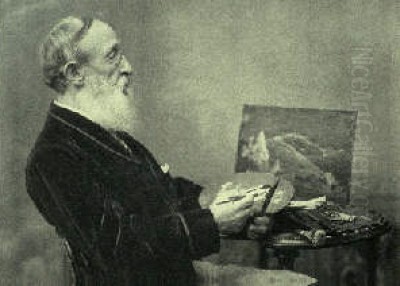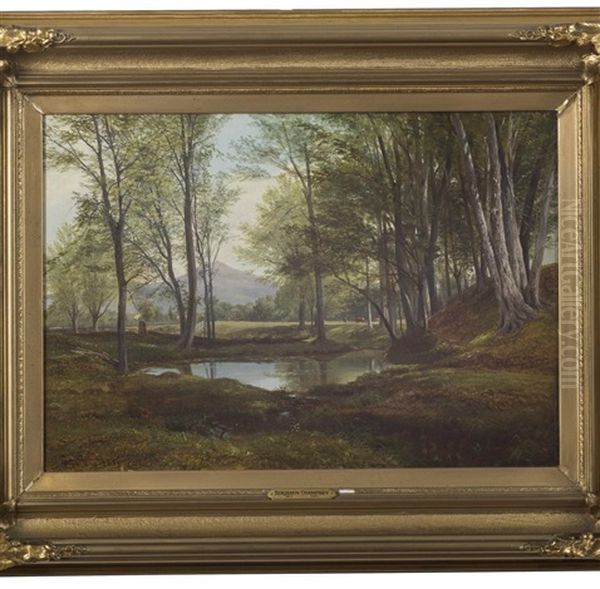
Benjamin Champney stands as a significant figure in 19th-century American art, celebrated primarily for his evocative landscape paintings of the White Mountains in New Hampshire. His long and productive career not only captured the beauty of this region but also played a crucial role in establishing it as a major center for American landscape painting. As a founder of the White Mountain School of art, Champney's influence extended beyond his own canvases, shaping the careers of other artists and contributing significantly to the cultural landscape of New England.
Early Life and Artistic Beginnings
Benjamin Champney was born in New Ipswich, New Hampshire, on November 20, 1817. His early life was marked by tragedy; his father, a lawyer, passed away when Benjamin was only two years old. Following this loss, his mother moved with her seven children to a nearby town, reportedly Arlenton (though the exact location might be referenced differently in various records), where the young Benjamin was raised by an aunt. This relocation set the stage for his eventual move towards a life in the arts.
At the age of sixteen, Champney sought opportunities in Boston. His initial foray into the working world involved a position at a shoe store. However, his artistic inclinations soon led him elsewhere. He secured an apprenticeship at a printing establishment, where he began learning the craft of lithography. This training proved formative, providing him with valuable technical skills in drawing and reproduction. Notably, he studied lithography techniques within the workshop of the renowned printer and future marine painter, Fitz Henry Lane, laying a foundational stone for his artistic journey.
European Studies and Broadening Horizons

Seeking to further his artistic education, Champney traveled to Paris in 1841. This pivotal move was reportedly made on the advice of the prominent American painter Washington Allston, whose influence underscored the importance of European study for aspiring American artists of the era. In Paris, Champney immersed himself in the vibrant art scene. Sources suggest he studied in the studio of Eugène Boudin, although details about his specific instructors can vary. A significant part of his learning process involved copying landscape paintings at the Louvre Museum, allowing him to absorb the techniques and styles of European masters.
During his time in Europe, Champney formed a lasting friendship with fellow American artist John Frederick Kensett. Together, they embarked on travels, including hiking excursions in Switzerland. These journeys were not merely for leisure; they were opportunities for artistic exploration. Champney and Kensett created landscape paintings based on their experiences, often working from memory and sketches made on site. Their shared interest extended to the works of 17th-century Dutch landscape painters, whose mastery of light and atmosphere likely influenced their developing styles. This period abroad was crucial for honing Champney's skills and shaping his artistic vision.
The White Mountains Beckon: Founding a School
Upon returning to the United States, Champney brought with him the techniques and sensibilities he had cultivated in Europe. He began applying the principles often associated with the Hudson River School – a movement pioneered by artists like Thomas Cole and Asher B. Durand, emphasizing detailed depiction and a romantic reverence for nature – to the landscapes of his native New England. He is widely credited as one of the key figures, if not the principal founder, of the White Mountain School of art.
His connection with the White Mountains deepened significantly around 1850. Discovering the scenic splendor of North Conway, New Hampshire, Champney recognized its immense potential as a subject for landscape painting. He established a studio there, a decision that would profoundly impact both his career and the region itself. He effectively transplanted the aesthetic focus of the Hudson River School into the forests, rivers, and peaks of New Hampshire, popularizing the area among artists and patrons alike.
Life and Work in North Conway
North Conway became Champney's artistic home base for over half a century. In 1853, he married and purchased a house situated between Conway and North Conway, which served as his cherished summer residence for more than fifty years. His studio quickly evolved into more than just a workspace; it became a social and artistic epicenter during the summer months. It attracted a diverse crowd, including fellow artists, collectors, and tourists eager to experience the region's beauty, both in person and through art.
Champney's presence was magnetic. His studio became a well-known destination, drawing artists from across the country who were inspired by his work and the landscapes he depicted. Figures associated with the Hudson River School and the burgeoning White Mountain School, such as Albert Bierstadt, Jasper Francis Cropsey, Sanford Robinson Gifford, and Aaron Draper Shattuck, were among those who painted in the region, contributing to its reputation as an artists' colony. Champney's popularity soared, and his paintings were frequently purchased by visitors as souvenirs, providing him with income and further stimulating the local art market and tourism.
Artistic Style: Romanticism and Detail
Champney's artistic style is firmly rooted in the American Romantic landscape tradition of the mid-19th century. Influenced by his Hudson River School predecessors and contemporaries, his work celebrates the grandeur and sublime beauty of the natural world. He possessed a keen eye for detail, meticulously rendering the textures of rocks, the foliage of trees, and the play of light across mountains and valleys. His paintings often evoke a sense of peace and harmony, inviting viewers to appreciate the intricacies of the New Hampshire wilderness.
While sharing affinities with the Hudson River School, Champney developed his own distinct approach. He was particularly adept at capturing the specific atmospheric conditions and unique character of the White Mountains, from the hazy light of summer afternoons to the clear, crisp air of autumn. His compositions often balanced panoramic vistas with intimate foreground details, showcasing both the vastness of the landscape and the delicate beauty found within it. This combination of broad scope and careful observation became a hallmark of his work and contributed to its wide appeal.
Notable Works and Panoramic Ventures
Among Champney's representative works is Thompson Falls and the Saco Valley, a painting that exemplifies his skill in capturing the specific topography and atmosphere of the White Mountains. He produced numerous canvases depicting iconic locations such as Mount Washington, Echo Lake, and the Saco River, contributing significantly to the visual identity of the region in the American imagination.
Beyond traditional easel paintings, Champney also engaged with the popular medium of the panorama. He created large-scale painted panoramas of European scenes, including one depicting the Rhine River. These ambitious works were exhibited in major cities like Boston and New York, capitalizing on the public's fascination with immersive visual experiences. Unfortunately, his Rhine panorama met a disastrous end; it was destroyed in a fire at the New York Crystal Palace exhibition, reportedly in 1857 (some sources may cite 1853 or 1858, reflecting potential discrepancies in historical accounts of the event). Despite this loss, his panoramic ventures highlight his ambition and engagement with popular art forms of the day.
Collaboration, Mentorship, and Artistic Community
Champney was not an isolated figure; he actively engaged with the artistic community of his time. His friendship and collaborative travels with John Frederick Kensett during their European years were foundational. Back in New England, he associated and sometimes collaborated with other prominent White Mountain artists, such as Edward Hill. Hill, born in England but active in the United States, also focused on the landscapes of the region, known for works like Eagle Cliff from Profile Lake and Franconia Notch from Northwood. Their shared dedication helped solidify the White Mountain School's identity.
Furthermore, Champney played a vital role as a mentor and facilitator for other artists. He guided numerous aspiring painters, both men and women, offering instruction and encouragement. Crucially, he helped introduce these artists to the Boston art market, leveraging his connections to promote their work. He was one of the founders of the Boston Art Club, a significant institution in the city's cultural life, and regularly exhibited his own paintings at the prestigious Boston Athenaeum. His studio in North Conway served as an informal academy and a gateway for artists seeking recognition.
The Wider Circle and Artistic Context
Benjamin Champney's career unfolded during a dynamic period in American art. He was a contemporary of major Hudson River School figures like Frederic Edwin Church, whose dramatic landscapes often explored more exotic locales, and later landscape painters such as George Inness, who moved towards a more Tonalist style. While Champney remained largely focused on the familiar scenery of New England, his work shared the era's deep engagement with nature as a source of national identity and spiritual solace.
His early training under Fitz Henry Lane connected him to the Luminist tendencies developing in American art, characterized by a focus on light and atmosphere. His adherence to detailed realism linked him to the Ruskinian principles advocated by some American critics. By establishing the White Mountain School, he carved out a distinct regional identity within the broader landscape movement, ensuring that the specific beauty of New Hampshire found a prominent place in American art history.
Legacy and Enduring Influence
Benjamin Champney passed away in 1907, leaving behind a rich legacy. His most enduring contribution was his central role in establishing and popularizing the White Mountain School of art. Through his paintings, his teaching, and his active presence in North Conway, he transformed the region into a premier destination for artists and tourists, intertwining art with the burgeoning tourism industry. His works remain beloved for their faithful and affectionate portrayals of New Hampshire's natural beauty.
He was instrumental in building Boston's art infrastructure through his co-founding of the Boston Art Club and his consistent participation in exhibitions. His paintings are held in numerous museum collections and continue to be appreciated for their artistic merit and historical significance. Champney's life and work serve as a testament to the power of art to capture the spirit of a place and to foster a community dedicated to its celebration. He remains a foundational figure in the story of American landscape painting.